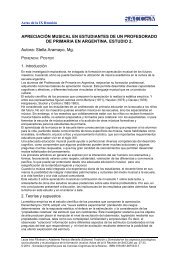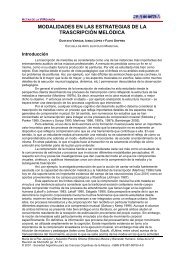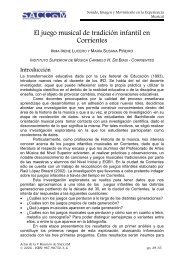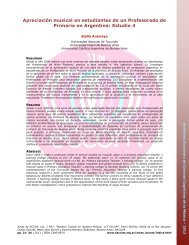NUESTRO CUERPO NUESTRA MÃSICA - Facultad de Bellas Artes
NUESTRO CUERPO NUESTRA MÃSICA - Facultad de Bellas Artes
NUESTRO CUERPO NUESTRA MÃSICA - Facultad de Bellas Artes
Create successful ePaper yourself
Turn your PDF publications into a flip-book with our unique Google optimized e-Paper software.
11 MO ENCUENTRO DE CIENCIAS COGNITIVAS DE LA MÚSICA<br />
Conclusiones<br />
En el análisis <strong>de</strong> las ejecuciones <strong>de</strong> los improvisadores pue<strong>de</strong> observarse el modo en el que<br />
reconfiguran su acción a partir <strong>de</strong> la aparición <strong>de</strong> cambios no previstos en la base, relativos a<br />
los aspectos armónicos. El modo en el que los improvisadores cambian la configuración <strong>de</strong> la<br />
altura se constituye en el elemento central para dar cuenta <strong>de</strong> esta reconfiguración. El hecho<br />
que se produzca un cambio en la base, no implica que el improvisador lo perciba con un nivel<br />
<strong>de</strong> conciencia gramatical, y el hecho <strong>de</strong> que lo perciba tampoco implica que el tipo <strong>de</strong> reacción<br />
<strong>de</strong>ba ser <strong>de</strong> adaptarse intentando alinearse con el cambio. Por otro lado el tipo <strong>de</strong> reflexión,<br />
foco y <strong>de</strong>cisiones en el <strong>de</strong>venir <strong>de</strong> la interacción <strong>de</strong>l improvisador con la base podría dar como<br />
resultado diferentes situaciones en el ciclo <strong>de</strong> percepción-acción suceptibles <strong>de</strong> ser observadas<br />
en el análisis. De este modo podría hipotetizarse que en algunos casos el ajuste se daría<br />
<strong>de</strong> manera automática dando menos posibilida<strong>de</strong>s al improvisador <strong>de</strong> hacer evaluaciones y<br />
tomar <strong>de</strong>cisiones concientes sobre lo percibido; mientras que en otros el improvisador evaluaría<br />
lo percibido y realizaría cambios más o menos instantáneos sobre su ejecución. Sobre esta<br />
reflexión podría afirmarse la coexistencia <strong>de</strong> evaluaciones diferentes con modos particulares<br />
<strong>de</strong> ‘conciencia en acto’ en la improvisación en curso, según dón<strong>de</strong> esté el foco en el <strong>de</strong>venir <strong>de</strong><br />
la percepción-acción <strong>de</strong>l sujeto.<br />
MAPPING'IDIOMATIC'ELEMENTS'IN'THE'MORPHOLOGY'OF'<br />
DANCE'GESTURES:'METER,'GENDER'AND'CULTURAL'<br />
IDIOSYNCRASIES'IN'THE'SAMBA'DANCE'AND'MUSIC<br />
LUIZ NAVEDA 1 AND MARC LEMAN 2<br />
1. Escola <strong>de</strong> Música. Universida<strong>de</strong> do Estado <strong>de</strong> Minas Gerais<br />
2. Institute for Psychoacoustics and Electronic Music. Ghent University<br />
Background<br />
Music and dance studies often avoid infringing the disciplinary divisions between music and<br />
dance, which is fair from a methodological viewpoint but odd from the cultural and cognitive<br />
perspective. Live cultures are not subjected to disciplinary divisions but also experience processes<br />
of fragmentation and accommodation caused by a variety of transformation and<br />
segmentation vectors. As a number of live Latin-American cultures, the culture of samba<br />
evolves, transforms and fragments itself across meaningful divisions in society. These divisions<br />
inclu<strong>de</strong>, for example gen<strong>de</strong>r roles, socio-economic (and geographic) levels, musical structure,<br />
their functions in context and the performing bodies, which do cross disciplinary boundaries<br />
and stretch the sound and movement displays to support <strong>de</strong>mands of cultural expression or<br />
cultural co<strong>de</strong>s. This results in very clear distinctions that we often call “styles” of dance and music<br />
such as the the samba-<strong>de</strong>-roda, the samba from Rio <strong>de</strong> Janeiro, from Bahia, the samba<br />
performed by professionals, the samba from the “terreiro” and even style characteristics that<br />
permit to i<strong>de</strong>ntify the gen<strong>de</strong>r of the dancers. How do we recognize and perform these fine idiomatic<br />
expressions that imprint different styles of gesture? Are these differences reflected in the<br />
structure of dance movements and musical sound or are they only an emergence of the mind<br />
of the observer? How strong is the impact these differences on the gestures and how they interact<br />
with music?<br />
Aims<br />
In this study aim at make an exploration of the emergence of these characteristics in the patterns<br />
of gestures of samba dancers.<br />
73












